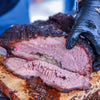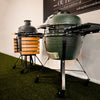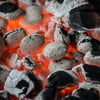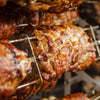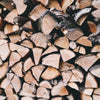Here’s just a couple of uses traditional wood cooking can have for food:
-
Improved Flavour
Depending on what wood you use can have a real effect on the flavour profiles that your food will have. For example, pecan wood offers slightly sweeter, nuttier notes whilst oak gives a stronger smoky flavour. We’ll cover this a bit later and tell you about the effects different species of wood give to your food.
-
More Heat for Longer
Hardwood burns hotter for longer due to the density of the wood; this makes cooking a lot easier for longer cooks. Versus traditionally charcoal that burns hot for a short period, hardwood offers slower, smouldering heat, making it ideal for kamados (See the Luxe Kamado here).
-
Combine for More Flavour
By adding damp wood chips to an existing fire, you can add subtle flavours notes, for example, smoked pork works great with this, just add a handful of applewood chips to a fire to add a slight sharp apple note.
What wood works best?
The answer to this depends on what you’re cooking and how you’re cooking, see below our recommendations for good pairings.
Oak
Due to its high density and thus high resistance to burning, oak is perfect for long smoking. This also makes it very versatile and can be paired with other woods for additional flavour. No matter what you’re smoking, it’s hard to go wrong with oak.
Beech
People often mistake beech for a softwood due to its light colouring however it is extremely hard and often smoulders when cut into thin shards. The light herbal flavour pairs excellently with oily fish and lighter meats such as chicken.
Alder
Most commonly used in traditional Scandinavian cooking, alder produces a sweet, almost honey like scent when burnt, great for smoking fish.
Apple
As I mentioned earlier, apple always pairs well with pork however the acidity and flavour can be well matched with other light meats such as chicken.
Chestnut
Well matched with Asian dishes that require simple cooking flavours, chestnut pairs well with meat, fish, or vegetables and doesn’t burn quickly. It can also be combined with oak to introduce a new flavour profile.
Hickory
Similar to oak, hickory is high density and thus high smoke, it’s most used in the smoking of bacon but works great with chicken.
Mesquite
This is one of the most popular woods used in Texan barbecue, it adds a very strong smoky flavour and helps give meat the iconic “smoke ring”.
Coconut Husks
This one may seem a little unconventional but trust us, it works. Used in throughout Bali, Indonesia, and other Asian countries, it gives a light sweet nutty and smoky.





